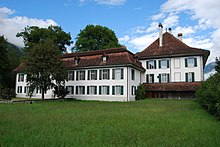Interlaken Monastery
The Interlaken Monastery is a former Augustinian canons prophet in Interlaken , Canton of Bern , Switzerland .
It was founded around 1130 by Otto Seliger von Oberhofen am Thunersee , co-owner of Oberhofen Castle , and closed in 1528.
history
1133 took Emperor Lothar III. the provost under his umbrella and this received the status of an imperial monastery . In 1220, Emperor Friedrich II granted the right to elect the castvogt . From 1472 the Kastvogtei lay with the city of Bern .
The convent was first mentioned in 1257. In 1449 serious complaints were made against the preacher monks at Interlaken. The monastery was called the vice school. In 1472 a general chapter was held because of “discord between nuns and monks”. Since little changed in the following years and the nunnery burned down out of carelessness, according to the papal bull the women's monastery was closed in 1484, among other things, "because of disorder and immorality". The number of canons never exceeded 30, that of nuns at times reached 300 and when the convent was dissolved it was eight or nine.
The monastery was handed over to Bern on March 13, 1528 and with it the goods that the monastery had acquired over the centuries: land in the Grindelwald Valley from Scheidegg to Alpiglen and reaching the lower glacier, the Jungfrauenberg (the Wengernalp, possibly the Wengernalp). Namesake for the Jungfrau ), the forest in Iseltwald , the churches of Grindelwald , Gsteig and Sigriswil , several estates in Brenzikofen , Oppligen and Otterbach as well as the church sentences Beatenberg , Belp , Bolligen , Erlenbach , Goldswil near Ringgenberg , Hilterfingen , Leissigen , Lyss , Meiringen , Muri near Bern , Nieder- and Obergurzelen , Scherzligen , Steffisburg , Thun , Thurnen and Zweisimmen . In addition, there were Alprechte in over eighty locations such as in Grindelwald, Habkern , Mürren , Saxeten , Wengen , in the Justistal and on the Schynigen Platte . In addition, there were 17.5 Jucharten (~ 6 ha) vineyards in Amsoldingen , Bern, Gunten , Steffisburg and Thun and the fishing rights enforced from Brienz to Weissenau .
The fact that the monastery people were responsible for the diversion of the Lütschinen into Lake Brienz is nowhere documented and is most likely a legend. It is unlikely that a (wooden) monastery was built in a swampy area. It is more likely that in primeval times the Lütschine flowed multi-armed towards Lake Brienz and Aare , so that the Bödeli was often transferred. And so the local population will have started early on to design an arm that flows into Lake Brienz by separating the other arm from the main arm and through structural measures to create a 'real' river bed, thereby draining the Bödeli. It would then be only logical that the monastery people helped with this. This assumption is supported by the decision in a dispute between the monastery and the brothers Konrad and Walter von Wädiswil on July 8, 1257.
In 1272 the monastery applied to the Lords of Unspunnen to build their 'Schyss'- or Spülibach brook to the monastery, starting from the derivation from the Lütschine from the foot of the Changeberg over the Allmend von Matten (1237 also called' aquaeductus de steige ' later 'Mühlewuhr').
When exactly the monastery began damming Lake Brienz in order to use the hydropower and 'divert' the grayling 's fishing trips , is open. As early as 1257, the monastery owned a mill in Ara mülli dorf (Aarmühle, Interlaken market square). From April 21, 1354, King Charles IV confirmed the fishing rights.
The New Castle
After the Reformation, part of the provost building was used as the official seat of the bailiff's administration, while another part was set up in 1532 as a hospital, which looked after people who got into poverty through no fault of their own. Between 1562 and 1563, under the government of Bern, the church choir was converted into a granary and a wine cellar. From 1746 to 1750 the west wing was torn down and the New Palace was built under Governor Samuel Tillier .
In addition to the governor's office, the court and land registry for the Interlaken-Oberhasli district are located here today. After the dissolution of the Landvogtei in 1798, Interlaken became the seat of the Oberamt in 1803 and from 1831 the main town of the district of the same name within the scope of the former Landvogtei Interlaken together with the former mayor's office in Unterseen.
See also
Web links
- Barbara Studer: Interlaken (monastery, administrative district). In: Historical Lexicon of Switzerland .
Individual evidence
- ↑ a b Barbara Studer: Interlaken Monastery. In: Historical Lexicon of Switzerland .
Coordinates: 46 ° 41 '13.9 " N , 7 ° 51' 52.6" E ; CH1903: 632 586 / one hundred seventy thousand seven hundred and fifty-two
